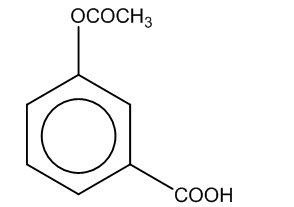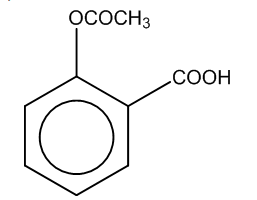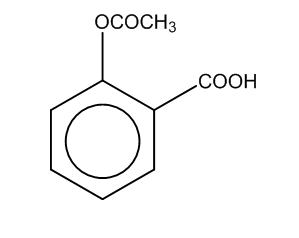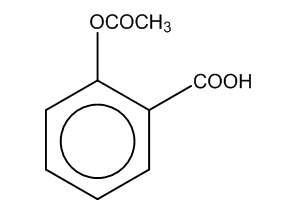
Sodium phenoxide when heated with CO$_2$, under pressure at 125$^\circ$C yields a product which on acetylation produces C.
The major product C would be:

(a)

(b)

(c)

(d)





Answer
216.3k+ views
Hint: This question is based on the concept of acetylation reaction. As we can see in the question that B to C conversion takes place through the acetyl group. This is the Kolbe-Schmitt reaction, so now the product can be identified.
Complete step by step answer:
Now, we will move step by step for this reaction.
As we know, sodium phenoxide is the sodium salt of phenol.
The first step is when sodium phenoxide reacts with carbon-dioxide at high temp, and 5 atm to produce the salicylate i.e.

In the first step, we can see that phenol group is attached to the benzene ring, and COO- group is attached with the sodium ion.
Thus, the product formed in the first step is B.
Now, if we perform the further reaction to attain the product C, then there is a reaction of salicylate formed with the acid i.e. sulphuric acid in the presence of an acetyl group.
Thus, the product formed is

Here, we can see that –COOH group is attached at the ortho position, and the product formed is C i.e. salicylic acid.It is also known as aspirin.
The second step of this reaction is an example of acetylation reaction.
As mentioned the whole reaction i.e. from sodium phenoxide to the formation of salicylic acid is Kolbe-Schmitt reaction.
Hence, the major product formed C is

The correct option is (C).
Note: Don’t get confused while writing the complete chemical reaction, just perform it step by step as shown. There is a difference between salicylate, and salicylic acid. Salicylic acid is formed by the reaction of salicylate with sulphuric acid. So, salicylate acts as a starting material for acetylation reaction.
Complete step by step answer:
Now, we will move step by step for this reaction.
As we know, sodium phenoxide is the sodium salt of phenol.
The first step is when sodium phenoxide reacts with carbon-dioxide at high temp, and 5 atm to produce the salicylate i.e.

In the first step, we can see that phenol group is attached to the benzene ring, and COO- group is attached with the sodium ion.
Thus, the product formed in the first step is B.
Now, if we perform the further reaction to attain the product C, then there is a reaction of salicylate formed with the acid i.e. sulphuric acid in the presence of an acetyl group.
Thus, the product formed is

Here, we can see that –COOH group is attached at the ortho position, and the product formed is C i.e. salicylic acid.It is also known as aspirin.
The second step of this reaction is an example of acetylation reaction.
As mentioned the whole reaction i.e. from sodium phenoxide to the formation of salicylic acid is Kolbe-Schmitt reaction.
Hence, the major product formed C is

The correct option is (C).
Note: Don’t get confused while writing the complete chemical reaction, just perform it step by step as shown. There is a difference between salicylate, and salicylic acid. Salicylic acid is formed by the reaction of salicylate with sulphuric acid. So, salicylate acts as a starting material for acetylation reaction.
Recently Updated Pages
Difference Between Alcohol and Phenol: Structure, Tests & Uses

Classification of Drugs in Chemistry: Types, Examples & Exam Guide

JEE Atomic Structure and Chemical Bonding important Concepts and Tips

JEE Amino Acids and Peptides Important Concepts and Tips for Exam Preparation

Electricity and Magnetism Explained: Key Concepts & Applications

Chemical Properties of Hydrogen - Important Concepts for JEE Exam Preparation

Trending doubts
JEE Main 2026: Application Form Open, Exam Dates, Syllabus, Eligibility & Question Papers

Derivation of Equation of Trajectory Explained for Students

Hybridisation in Chemistry – Concept, Types & Applications

Understanding the Angle of Deviation in a Prism

Understanding Collisions: Types and Examples for Students

How to Convert a Galvanometer into an Ammeter or Voltmeter

Other Pages
NCERT Solutions For Class 12 Chemistry Chapter 1 Solutions - 2025-26

NCERT Solutions for Class 12 Chemistry Chapter Chapter 7 Alcohol Phenol and Ether

NCERT Solutions ForClass 12 Chemistry Chapter Chapter 8 Aldehydes Ketones And Carboxylic Acids

JEE Advanced Marks vs Ranks 2025: Understanding Category-wise Qualifying Marks and Previous Year Cut-offs

Haloalkanes and Haloarenes Class 12 Chemistry Chapter 6 CBSE Notes - 2025-26

Solutions Class 12 Chemistry Chapter 1 CBSE Notes - 2025-26




